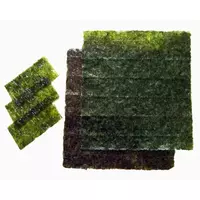Nori seaweed

In Japan, under the word nori, some types of edible red algae are hidden, as well as products prepared with their use. For a long time, a dish was associated with the concept of nori, which in its appearance resembled a paste made from algae. And only after some time did nori algae begin to look as we are used to - in the form of the thinnest dried leaves from compressed algae.
Today, nori algae is produced in 3 varieties: A (Gold), B (Silver) and C (Red or Green). The most elite with excellent quality are considered nori of grade A, which are quite plastic and quite durable, have a saturated green color and an even texture. They are distinguished by a savory marine aroma and do not break during the twisting process. The remaining 2 varieties are significantly inferior in quality and such sheets can be distinguished by color - reddish, pale green or reddish. They cannot boast of excessive strength, since when twisted, they often crack.
To taste, fried nori algae resembles sardines. The use of nori sheets is not limited to preparing sushi: they are added to soups, salads and fillings for sandwiches. You can prepare a dish that, in addition to nori, includes fish, vegetables, rice. The calorie content of nori algae per 100 grams is 349 kcal, but this is very small, considering that 1 leaf weighs about two grams. If properly stored in a dry place in a sealed package, nori algae remains suitable for consumption for a long time.
In the historical homeland, in Japan, three types of nori algae are most popular: nori-maki, yaki-nori and ava-nori. The former are mainly used to make sushi, rolls, as well as mochi (rice cake) and onigiri (rice balls). Yaki nori is obtained by frying nori sheets to enhance their aroma and taste. These algae are widely used as one of the components for second courses and snacks. In addition, an excellent base for soups is prepared from yaki nori. In order to prepare a rich and nutritious broth, which, due to the low calorie content of nori algae, anyone can afford, you just need to fill the dried algae with hot water. As a fragrant seasoning for traditional Japanese noodles, ava nori is used, which are obtained by rubbing fresh nori.
The Benefits of Nori
The benefits of nori algae, as well as many types of algae, are known not only to fans of Japanese cuisine, but also to ordinary consumers, due to the fact that they contain iodine, plant protein, vitamins and minerals. With regular eating of nori, a significant decrease in blood cholesterol levels was noticed, which indicates a small probability of getting atherosclerosis. Observations by scientists have shown that algae have anti-cancer properties, as well as contribute to the restoration of the immune system.
The benefit of nori algae lies not only in the ability to remove radioactive substances and toxic metals from the body, but also to strengthen the cardiovascular system. For thyroid diseases and varicose veins, these algae provide effective assistance if added to your daily diet.
seaweed nori 349 kCal
The energy value of nori algae (Ratio of proteins, fats, carbohydrates - ju):
Proteins: 46.1 g (~ 184 kCal)
Fats: 0.1 g (~ 1 kCal)
Carbohydrates: 41g (~ 164kCal)
Energy ratio (bj | y): 53% | 0% | 47%
 Español
Español Français
Français Português
Português Русский
Русский 简体中文
简体中文 繁體中文
繁體中文 日本語
日本語 한국어
한국어 العربية
العربية Türkçe
Türkçe Қазақ
Қазақ Deutsch
Deutsch Italiano
Italiano Українська
Українська
